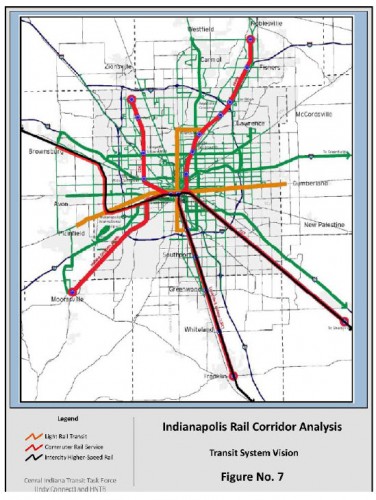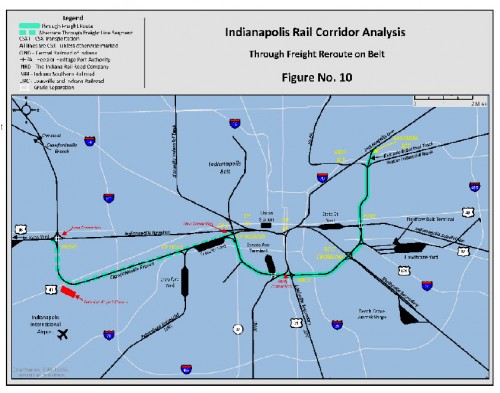
Recently, the Indianapolis MPO released a report (click to open 33 page .pdf) created to examine the spaghetti bowl of freight train traffic that comes and goes in the Indianapolis region. While this wasn’t a point of major debate through out the Indyconnect meeting periods, it bares a lot of responsibility when it comes to firming up the underbelly of passenger rail connections in the Indyconnect plan. On my personal blog, I touched on this months ago and cited a report created in 2004 that explored moving freight traffic to the old belt railway that circles the DT area. In that post, I asked the question about how commuter trains would efficiently use Union Station as the region’s passenger hub, and maintain freight traffic without conflicts. Apparently someone at the MPO has already been thinking about this….
The new report, released in September of 2010, pre-dates the latest Indyconnect release and paints a picture of what could be in the region’s very long term transportation future. Multiple commuter rail and light rail lines are painted on the map as a means of quantitatively crafting a plan that would divert freight trains off of lines through downtown Indianapolis, and onto the belt railway. Currently, freight traffic dominates the regions railways. According to the executive summary:
- “Businesses in the Indianapolis MPO area originated and/or terminated over 100,000 carloads containing 7 million tons of freight in 2005”Â
- Â “Passenger service is provided by Amtrak with two trains, the Cardinal and Hoosier State, which combined provide service between Chicago and New York City. Amtrak trains arrive at and depart from Union Station”
The executive summary makes the following conclusion:
- From an operating standpoint, separation of freight and passenger trains would provide the best approach
to resolve or mitigate issues associated with freight and passenger trains operating on the same track.
Relocating freight trains to the Belt, a rail line that provides a circular route around most of Indianapolis
was investigated previously, principally for safety reasons, but is now being reconsidered to
accommodate passenger train access to the center city. This alternative appears to represent the most
comprehensive approach when considering all potential intercity and commuter passenger services. But,
even it is not without problems

Complicating matters seem to be the Citizens Gas plant located downtown which is fed a steady diet of coal, and also the GM plant on the west side of the White River, both of which actively depend on the freight lines. In addition to the bulk of freight already present, future commuter lines originating from Shelbyville and Mooresville cloud the picture; as does the ever present specter of high speed rail. In solving this, the MPO and it’s partner, Wilber Smith Associates, recommend some sort of action if passenger traffic is to be accommodated using Union Station. What this is, remains to be seen however as a concrete plan is not laid out in the study. Multiple recommendations are given in respect to the currently proposed commuter lines which appear to be somewhat safe. If future commuter traffic from the other suburbs, as well as touched on lines from Muncie and Bloomington, are to be accommodated, further study will need to be put in place to figure out how to keep passenger rail and freight rail separated.
Wrap Up
In this study, I see a vision for a larger passenger rail plan for Indianapolis. I’m not sure that I agree with so many commuter trains coming and going, but I do appreciate the vision of light rail to the Broad Ripple area, as well as south towards the University of Indianapolis. While none of this was talked about specifically in the current Indyconnect plan, it paints a picture of what planners thought about when considering the current plan. I have it from higher authority, that the long range plan’s budget accommodates some sort of belt renewal. However, no other details were given and this planning document from the MPO represents the only official piece I can find. This document could help paint the picture of what the next long range plan could look like; or the current one, should funding or public sentiment push more light rail interests forward. To review the report, click this link to open the .pdf in a new window.